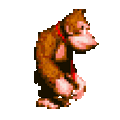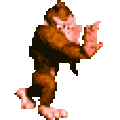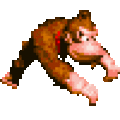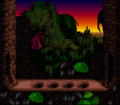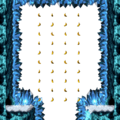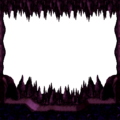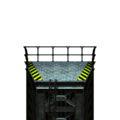This article is under construction. Therefore, please excuse its informal appearance while it is being worked on. We hope to have it completed as soon as possible.
This is a list of pre-release and unused content for the game Donkey Kong Country.
Early iteration[edit]
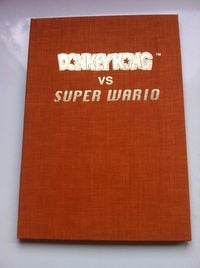
Donkey Kong vs. Super Wario - During September 2015, Donkey Kong Country designer Gregg Mayles posted many pieces of concept art and early pitches for the game, including a binder named Donkey Kong vs. Super Wario.[1] No other media of the pitch was posted and when asked about its content, Mayles responded "Didn't get much beyond Wario and some kind of time machine as I recall."[1] Eventually, he posted an actual storyboard of it to Twitter, showing Wario stealing a time machine Mario invented and turning him to stone using a "futuristic beam gun" in order to "rule Nintendo Land," with a parrot seeing this and going to Donkey Kong for help.[2] According to Gregg Mayles, this pitch was not pursued because Nintendo wanted the villains to be new characters.[3]
- Mayles posted another pitch titled Donkey Kong and the Golden Bananas, which is more similar to the final game. From the four pages posted on his Twitter, the storyline in the pitch shows Donkey Kong guarding the Golden Banana while relaxing. A lanky blue Kremling named Korporal Krizzle defeats DK and steals the Golden Banana. Grandpa Kong (an early version of Cranky Kong resembling a white-furred DK) finds Donkey Kong and urges him to get back the artifact. Donkey then calls Donkey Kong Junior, whose design is nearly identical to Diddy Kong, albeit without a tail.[4]
- Mayles revealed on August 10th, 2018, that a working title for Donkey Kong Country was Monkey Madness around March 1994.[5]
Early concepts[edit]
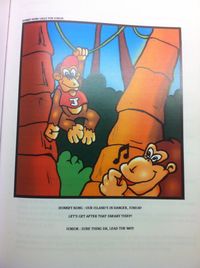
Diddy Kong's original look
- The SNES version was planned to have an introduction cutscene, showing Diddy being stomped by Krusha while patrolling. Krusha then smashed the wall leading to the Banana Hoard and Kremlings loaded the bananas in carts, followed by Donkey Kong waking up and Cranky explaining to him the bananas have been stolen.[6] A very similar intro would be used in the GBA remake.
- Donkey Kong Jr. was originally meant to be Donkey Kong's sidekick during the concept phase, but Nintendo felt that Rare's redesign was too different and mandated them to either revert to Donkey Kong Jr.'s original appearance or change the name of the character. Rare felt that the design fit Donkey Kong Country's new aesthetic more, leading to Diddy becoming a separate character.[7]
- Several names were then considered for Diddy during Donkey Kong Country's production, including "Diet DK", "DK Lite" and "Titchy Kong". Rare had originally settled on "Dinky Kong", but the name was later dropped due to legal considerations[7] with Dinky Toys.[8] It would later become Kiddy Kong's Japanese name.
- Donkey Kong originally had a helmet light for mine stages, which could be seen on many of the marketing materials. In the final game, Squawks replaces the helmet's intended functionality.[9][10]
- The concept for the King K. Rool battle is largely similar to that of the final game, except that K. Rool was planned to only endure three hits for each phase of the battle.[6] Additionally, he was originally named “Krudd”.[10]
- Early during the pre-production phase, it was considered to have the Animal Friends trapped in cages, with the player being required to find a Key item to free them.[11]
- Kevin Bayliss originally named the rhinoceros helper RhinoRider and then variations of Rhidocerus before settling on Rambi.[12]
- Some animal helpers that did not make the final cut included a dolphin, an owl (named Hooter[5]) that would give players information, a fox that would reveal secrets, snakes that could be used as vines, a giraffe whose long neck would help the Kongs reach high areas, a flying pig,[13] and a mole named Miney.[5] The giraffe was revealed to a fan that happened to ask about a giraffe in a new game in an old Scribes page on the Rareware website, where it was mentioned that he would allow Donkey Kong to crawl up his neck and reach high items and secrets. The flying pig may have been repurposed into a similar-sounding enemy in Donkey Kong Land.
- Cut Kremlings include a magician Kremling named Kloak (potentially the enemy of the same name which later appears in Donkey Kong Country 2: Diddy's Kong Quest), a statue Kremling named Krumble, a green Kremling named Klanger, and a robot Kremling named Krocbot.[5] Graphics for a robotic Kremling can be found in the game's data, which may be Krocbot.[14]
- Of note is that "Klanger" is not crossed out on the list and that "Kritter" is referred to as a "little" Kremling (which it is not in the final), suggesting they may have been combined into one for the final.
- Other cut enemies used in later games include Puftup, Shuri, and Gloop. Other enemy names listed are for a fireball called Fizzle, a fish called Bloop (likely a counterpart for Gloop; of note is that Bitesize and Chomps Jr. are not mentioned), a "nasty beetle" called Veedub, a yeti or iceman called Frozone, and a moray eel called Mobo.[15]
- Rockkroc was originally known as "Krocrock," keeping with the "K" theme.[5] Slippa was known as "Mr. Hister," Squidge as "Mr. Squidge," and Clambo as "Ms. Clamity." King K. Rool is referred to as "Kommander K. Rool;" this early rank may be referenced in the final, where "Kommander" is listed as his role in the fake "kredits."
- A predecessor to Slippa known as Spitz would have additionally had a hooded variant that spits stunning venom.[12]
- Before Donkey Kong's roll and Diddy Kong's cartwheel, other moves were considered, such as slide and leapfrog moves, but were cut due to not being fluid enough.[16]
Early builds[edit]
The preview video, Donkey Kong Country Exposed, also contains a few elements that never made it into the final game, such as a nighttime version of Jungle Hijinxs. There were also a few instances where binary digits were seen underneath the lives counter, which may have been a debug menu of some sort. Also, in this build, it was possible to exceed one hundred bananas, whereas in the final game, the banana counter would reset once it reaches that number. Lastly, Donkey Kong was unable to defeat the regular blue Krusha enemy by jumping on him. Unlike the final, Krusha will laugh after Donkey Kong does so, as he would if Diddy had done that. This also applies to Klump, hinting there might have not been character differences in the early game.
Unused data[edit]

Bananas in an arrow shape
There are many unused sprites in this game, such as a Puftup that was later used (with more defined fins) in Donkey Kong Country 2, a jungle plant,[17] various poses and animations for Donkey Kong and Diddy Kong (including a pushing sprite, an action not performable in the final game),[18][19] and a few enemy palette swaps.[20] Also of note is an early Necky that is roughly the size of the Mini-Neckys in the final game, but colored like the adult ones; its animations indicate that it would attack like the ground-based adults in the final, and as such, this may be an early design that both were derived from.[20]
There are a few unused sprites for Puftup, who would later be an enemy in Donkey Kong Country 2: Diddy's Kong Quest. There are also unused sprites for both Donkey Kong and Diddy Kong. Additional letters similar to the K-O-N-G Letters appear in some bonus rooms, though not all letters in the alphabet are used, and the game appears to have the entire alphabet left in the game's coding. The letters F, H, J, L, Q, V, and Z are never used in the game. Slippa has an unused death animation. There is an unused lightning bolt sprite that was presumably meant for Ropey Rampage, which included a lightning effect. There is an unused animation of Cranky being able to walk, which was later added into the Game Boy Advance remake.
The ROM includes a partial English script, which seems to be from an earlier period of development. Differences include Cranky Kong's dialogue being much friendlier than he is in the final game and the Slippa enemy being named "Hister."[20]
Unused sprites of Donkey Kong kicking
Unused sprites of Donkey Kong scratching his head
Unused sprites of Donkey Kong posing
Unused sprites of Donkey Kong pushing
Unused sprites of Donkey Kong turning underwater
Unused object subtypes[edit]
A sizable number of object variations are unused in game. To see them, the player must go to ROM address 3D962A and change the value from B413 to the given object ID.
Dirt Patch[edit]
| Object ID
|
9AAB
|
9AB7
|
| Item Given
|
Rambi Token
|
Expresso Token
|
Kritter[edit]
| Object ID
|
9B91
|
A4A1
|
A4AF
|
| Color
|
Gold
|
Green
|
Green
|
| Movement Type
|
Horizontal + Jumping
|
Horizontal
|
Horizontal
|
| Movement Range
|
96 pixels
|
30 pixels
|
300 pixels
|
| Spawn Position
|
Rightmost point in path
|
Center of path
|
Center of path
|
| Object ID
|
9DC9
|
A037
|
| Color
|
Yellow
|
Orange
|
| Movement Type
|
Vertical
|
Horizontal
|
| Movement Range
|
140 pixels
|
100 pixels
|
| Speed
|
4 pixels per frame
|
7 pixels per frame
|
| Spawn Position
|
Highest point in path
|
Center of path
|
| Object ID
|
B075
|
B2C9
|
B32B
|
| Movement Type
|
Rotation - Counterclockwise
|
Horizontal
|
Horizontal
|
| Movement Range
|
110 pixels
|
235 pixels
|
440 pixels
|
| Speed
|
1 rotation per 30 frames
|
8 pixels per frame
|
8 pixels per frame
|
| Spawn Position
|
Center of path
|
Highest point in path
|
Highest point in path
|
| Object ID
|
B41D
|
| Movement Type
|
Backwards from spawn point
|
| Movement Range
|
Infinite
|
| Object ID
|
B521
|
B52F
|
B54B
|
B567
|
B599
|
| Movement Range
|
150 pixels
|
110 pixels
|
70 pixels
|
200 pixels
|
40 pixels
|
| Spawn Position
|
15 pixels right of leftmost point in path
|
50 pixels right of leftmost point in path
|
Center of path
|
Center of path
|
Center of path
|
Mini Necky[edit]
| Object ID
|
B877
|
B8A9
|
| Color
|
Yellow
|
Yellow
|
| Movement Type
|
Vertical - doesn't loop
|
Vertical - doesn't loop
|
| Movement Range
|
225 pixels
|
100 pixels
|
| Spawn Position
|
Lowest point in path
|
10 pixels up from center of path
|
| Firing Delay
|
60 frames
|
45 frames
|
Arrow Platform[edit]
| Object ID
|
BAA1
|
BAE7
|
BB11
|
BB1F
|
| Movement Type
|
Horizontal - Moves right
|
Horizontal - Moves right
|
Horizontal - Moves right
|
Horizontal - Moves right
|
| Movement Range
|
230 pixels
|
370 pixels
|
260 pixels
|
300 pixels
|
| Speed
|
4 pixels per frame
|
2 pixels per frame
|
2 pixels per frame
|
4 pixels per frame
|
Necky (Flying)[edit]
| Object ID
|
BCE1
|
BCF3
|
BD53
|
| Movement Type
|
Vertical
|
Horizontal
|
Horizontal - Backwards from spawn point
|
| Movement Range
|
110 pixels
|
160 pixels
|
Infinite
|
| Speed
|
8 pixels per frame
|
8 pixels per frame
|
4 pixels per frame
|
| Spawn Position
|
25 points below highest point in path
|
70 points right of leftmost point in path
|
|
Manky Kong[edit]
| Object ID
|
BDC7
|
BDD1
|
BDDB
|
| Projectile Speed
|
3 / 4 pixels per frame (alternates)
|
4 pixels per frame
|
2 / 4 / 2 pixels per frame (Behavior loops)
|
| Firing Delay
|
60 frames
|
60 / 45 / 30 / 15 frames (Behavior loops)
|
75 / 60 / 75 frames (Behavior loops)
|
| Object ID
|
BED3
|
BEE1
|
BF57
|
C065
|
| Type
|
Conveyor rope - downward
|
Conveyor rope - downward
|
Hanging rope
|
Hanging rope
|
| Movement Type
|
|
|
Horizontal
|
Horizontal - Moves right, doesn't loop
|
| Movement Range
|
|
|
300 pixels
|
1150 pixels
|
| Speed
|
4 pixels per frame
|
2 pixels per frame
|
5 pixels per frame
|
5 pixels per frame
|
| Spawn Position
|
|
|
Center of path
|
|
Dumb Drum[edit]
| Object ID
|
C4FD
|
C507
|
C511
|
C5A3
|
C5AD
|
C5B7
|
| Orientation
|
Normal
|
Normal
|
Normal
|
Upside down
|
Upside down
|
Upside down
|
| Object Fired
|
Klaptrap
|
2 Klaptraps
|
2 Armys
|
Slippa
|
Army
|
Army
|
| Firing Direction
|
Front and back
|
Front
|
Front
|
Front
|
Front
|
Front
|
| Firing Delay
|
75 frames
|
75 frames
|
75 frames
|
75 frames
|
600 frames
|
300 frames
|
Necky (Firing Nuts)[edit]
| Object ID
|
C717
|
C72B
|
| Projectiles Fired
|
5
|
2
|
| Projectile Directions
|
Semicircle arc
|
Backward, downwards
|
Blast Barrel[edit]
| Object ID
|
CA8D
|
| Movement Type
|
Horizontal
|
| Movement Range
|
220 pixels
|
| Speed
|
12 pixels per frame
|
| Spawn Position
|
55 pixels right of leftmost point in path
|
| Firing Direction
|
Right
|
| Firing Distance
|
440 pixels
|
Fuel Barrel[edit]
| Object ID
|
E055
|
| Units
|
2 units
|
Rockkroc[edit]
| Object ID
|
E50B
|
E519
|
| Movement Range
|
214 pixels
|
40 pixels
|
| Speed
|
12 pixels per frame
|
12 pixels per frame
|
| Spawn Position
|
Center of path
|
Center of path
|
Gallery[edit]
Concepts and designs[edit]
General character and baddie names
Kritter, bearing a resemblance to Krunch's eventual design
Donkey Kong vs. Super Wario[edit]
Mario is done with the time machine.
Wario contemplates his new future gun.
A parrot tells Donkey Kong of what has transpired.
Donkey Kong and the Golden Bananas[edit]
Donkey Kong relaxing on his hammock
Korporal Krizzle stealing the Golden Banana
Grandpa Kong tells Donkey Kong to retrieve the Golden Banana
Donkey Kong tells Junior (Diddy Kong) to come with him to recover the Golden Banana
Screenshots[edit]
Jungle Hijinxs with a nighttime setting. The Barrel and Expresso token are also missing.
Donkey Kong and Diddy Kong have managed to collect 659 bananas.
Klump manages to withstand Donkey Kong's jump attack, as he would have with Diddy's in the final.
The Extra Life Balloon is right next to Donkey Kong's treehouse, unlike the final, where it was a few trees further.
As with Klump, Donkey Kong is unable to inflict any damage on Krusha by jumping on him.
Unused jungle arena where Dumb Drum was once fought
Sprites[edit]
Bonus room maps[edit]
References[edit]
- ^ a b https://twitter.com/Ghoulyboy/status/644266725375148033
- ^ Donkey Kong vs. Super Wario storyboards
- ^ "It's an early pitch we made to Nintendo that eventually became DKC. They wanted all new bad guys, so we used our reptile Kremlings instead. I still have the book somewhere, but I'm sure I tweeted a some images from inside a few years ago", Gregg Mayles in a September 25, 2019 twitter post
- ^ Cover of Golden Bananas and Golden Bananas concepts from Gregg Mayles on Twitter
- ^ a b c d e https://twitter.com/Ghoulyboy/status/1027946702270021638
- ^ a b https://twitter.com/Ghoulyboy/status/643931780114960384/
- ^ a b The Making Of Donkey Kong Country (accessed February 20, 2012)
- ^ Shesez (November 21, 2019). The Donkey Kong Country 25th Anniversary Interview Documentary (14m03s). YouTube. Retrieved August 8, 2023.
- ^ Mark Stevenson on Twitter, retrieved June 6, 2015.
- ^ a b Playing With Super Power: Nintendo Super NES Classics eGuide, Donkey Kong Country 16 Bits Tab.
- ^ https://twitter.com/Ghoulyboy/status/643931780114960384
- ^ a b DK Creations Ltd. (January 19, 2021). Lost Artwork for Donkey Kong Country. YouTube. Retrieved September 10, 2022.
- ^ Playing With Super Power: Nintendo Super NES Classics eGuide, Donkey Kong Country Animal Buddies Tab.
- ^ The Spriters Resource
- ^ Early Donkey Kong Country general naming sheetMedia:DKC general naming.jpg
- ^ Shesez (November 21, 2019). The Donkey Kong Country 25th Anniversary Interview Documentary (19m50s). YouTube. Retrieved August 8, 2023.
- ^ Unused DKC sprites
- ^ Unused Donkey Kong sprites
- ^ Unused Diddy sprites
- ^ a b c The Cutting Room Floor
External links[edit]




